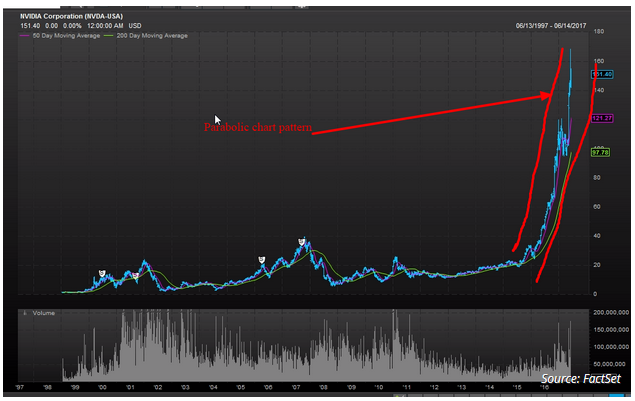Godfather of Chart Analysis Says Dow Can Hit 22,900 — as Long as Tech Doesn’t ‘Roll Over’
Can the Dow Jones Industrial Average surge above 22,000 this year?
Prominent market technician Ralph Acampora thinks the stock market, and specifically the Dow Jones Industrial Average, has more than 7% left to climb by the end of the year, if the technology sector doesn’t buckle under the weight of persistent worries about valuations.
Acampora, an analyst whom some have dubbed the godfather of technical analysis for his role in bringing to prominence techniques using charts and other technical tools to underpin investing strategies, told MarketWatch recently that he maintains a sanguine outlook for Wall Street, despite recent convulsions in the technology sector, and is forecasting that the Dow DJIA can reach a new high-water mark of 22,900 by the end of 2017.
The market technician said the one proviso is that highflying technology names, which enjoyed a respite in the green on Tuesday after a two-session beat-down, stay above their recently minted lows. “As far as technology is concerned, as long as we stay above the lows that were made [Monday] in Facebook and Google, as long as we hold those levels and don’t roll over, we are all right,” Acampora said.
In the case of Facebook Inc. shares FB that recent low is $144.56 in intraday trade, with a close at $148.44; as for Google parent Alphabet’s stock, Class A shares GOOGL hit a low of $936.80 before ending Monday’s session at $961.81, while Class S shares GOOG moved as low as $915.23 before a $942.40 close. Shares of Nvidia Corp. NVDA — last year’s best performing stock in the S&P 500 index SPX — hit a low of $142.11 before finishing at $149.97 on Monday.
During that Monday session, the Nasdaq Composite Index COMP hit a low of 6,110 before closing at 6,175, bringing the tech-heavy gauge’s two-day drop to 2.31%.
The tech sector enjoyed a reprieve from that slump on Tuesday, helping the Dow, the S&P 500 and the small-capitalization focused Russell 2000 index RUT all finish at all-time highs. The Nasdaq Composite was also up, by just shy of 0.1%, early Wednesday.
Acampora said that he has been stunned by the longevity of bullishness in such tech-sector names as Amazon.com Inc. AMZN and its fellow behemoths, which have become some of the more widely traded securities and which have endured a recent drubbing.
“As a technician, I get a nosebleed looking at some of these charts of these tech stocks. They’re getting parabolic — they have been for a while,” Acampora said, referring to the steep rise in the value of the technology sector over the past few years (see chart below, which shows the spectacular rise of Nvidia’s shares):

That said, parabolic patterns sustain for an extended period, the market technician said, particularly if Friday and Monday’s sudden jolt lower represented a cathartic pullback that allows for further gains.
The director of technical analysis for investment fund Altaira Ltd. of London, Acampora said his optimism also is tied to what some have described as a healthy rotation into other sectors of the market, even as tech took a hit. He also pointed to the rise in shares of small-cap companies, which tend to prosper when investors maintain an upbeat economic outlook.
“The lifeline of a bull market is a rotation, and that’s what we’re getting here, and that’s healthy,” he said.
However, valuations may remain a nagging matter in tech, with investors debating whether the sector is approaching bubble territory.
A Capital Economics research report on Monday made the case that, on a relative basis, tech isn’t as rich as some might fear, given that Amazon trades at a price-to-earnings ratio — one popular measure of a stock’s market valuation — of 182 times, compared with an S&P 500 average P/E of 22 times.
“Nonetheless, the valuations of shares in the technology sector do not seem to be stretched relative to those in the broader market, based on a comparison of their price [vs.] estimated operating earnings ratios. This is quite different to the situation before the dot-com bubble burst, when the valuations of technology companies often appeared to have little to do with their ability to generate income,” John Higgins, chief market economist at Capital Economics, wrote.
To be sure, the Capital Economics report doesn’t maintain a bullish outlook on the overall stock market because the firm contends that companies’ abilities to squeeze out profit in the future is limited.
Meanwhile, investors are increasingly worried that U.S. equities are overvalued, with a recent Bank of America Merrill Lynch survey indicating that a record 44% of investors polled now see stocks as pricey. That’s up from 37% last month.
That survey also indicates that 38% of investors see the Nasdaq Composite as the most overcrowded trade so far in June.
“Market vulnerability to profit weakness is very high,” said Michael Hartnett, B. of A. Merrill Lynch’s chief investment strategist, “with investors’ perception of excess valuation coinciding with high global profit expectations.”
Article and media originally published by Mark DeCambre at marketwatch.com